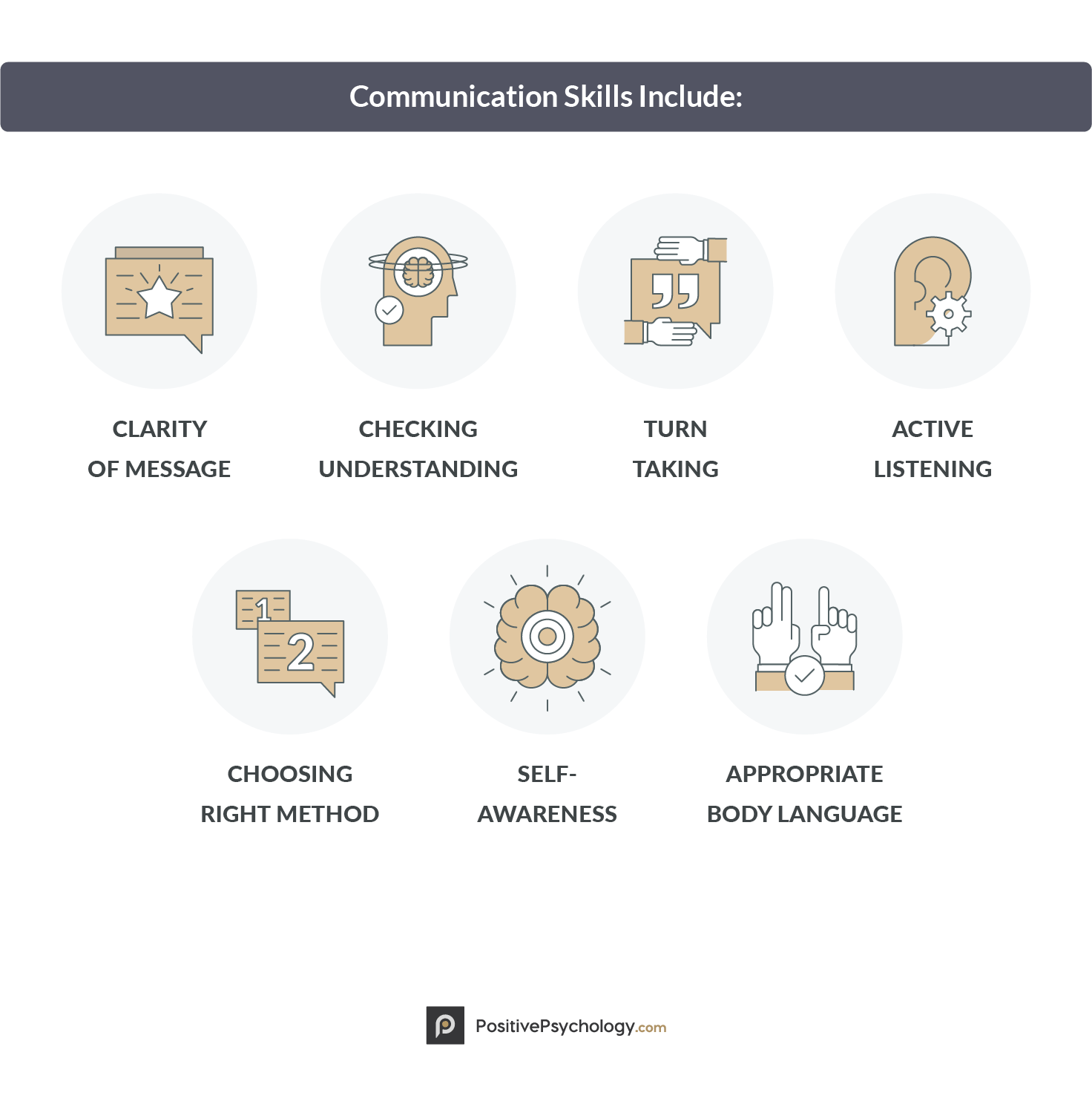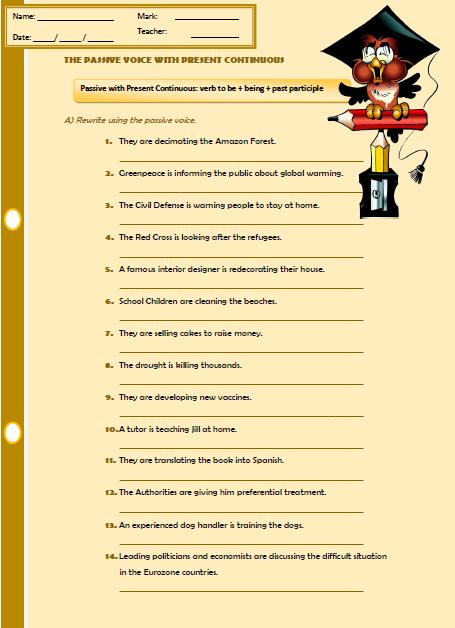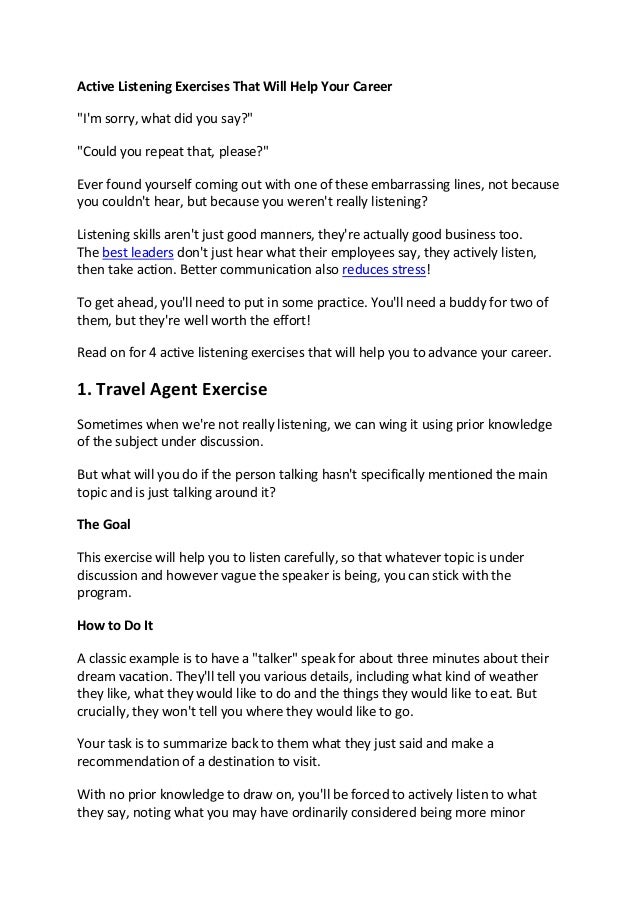When you have a medium-large group of people, it can sometimes be hard to get them all to listen. Sometimes large groups can create more energy in the classroom, making it harder for your students to focus. This is especially true for younger students. Even if you do manage to get your entire class to quiet down, how do you know if they are really listening?
- Active Listening Exercises For Students
- Active Listening Exercises Team
- Active Listening Exercises On Video
- Active Listening Exercises For Middle School Students
- Active Listening Exercises Video
The following article will tell you about some ways in which you can carry out certain active listening exercises to improve this skill. Learning to listen to each other more carefully can build their ability and confidence in real-life situations, in which they will need to focus on both listening and speaking.

Listening is a skill. Even when you listen to someone speak in your native language, it may be difficult to stay focused and not let your mind drift. Imagine how much more difficult it is for your students who are listening to a second or third language! So what are some great exercises and activities to help your students get better listening skills? We’ve compiled a list of five listening activities that work well for group lessons.
1. Draw This. One way to get your group to listen is to make sure they are unaware of the fact that it’s a listening game. In “Draw This” your students will simply think they are drawing. So how does it work? Give each of your students a blank piece of paper. Now, give one drawing instruction such as “Draw a square”. Then, ask your students to pass the paper to the next student so that everyone has a new paper. Now, give another drawing instruction such as, “Under the square, draw a triangle.” Keep giving instructions until the papers have made it all the way around the room. Now see which papers have turned out correctly. You can modify the instructions according to the language level of your students.

2. Daily Quiz. In order to get your students to pay attention throughout the lesson, it’s a good idea to give them a fun listening quiz at the end of the day. You can make the questions entertaining. For example, if you told your students an anecdote about your dog, one of the questions could be “What was the dog’s name?” The quiz should only be 2-5 questions long. The student(s) who get the most right answers get a gold star. At the end of every month the student with the most gold stars gets a prize like choosing a game to play, leading an activity, or sharing with the class 15 minutes of his/her favourite film (in the language you are teaching, of course). This reward system takes the heaviness out of the word “quiz”.
Even when you listen to someone speak in your native language, it may be difficult to stay focused and not let your mind drift. Imagine how much more difficult it is for your students who are listening to a second or third language!
3. Story Listening. Read your students a story. After the story, summarize the story as a group. Call on one student to tell the first significant event in the story, then another student for the next and so on. The students will have to work hard to listen so as not to let their classmates down!
4. Landmine Listening. The name sounds scary, doesn’t it? Don’t worry; this is a simple game which your students will love! First, clear all the desks to the side of the classroom. Then, choose two students to be blindfolded and two students to direct those students. After the two are blindfolded, quickly pull chairs and desks into the center of the classroom, creating an obstacle course or “landmine”. After the landmine is set up, have the two blindfolded students start at one end of the room and have the other two give instructions on how to get through to the other side. If the blindfolded student runs into a landmine, they are out. The first one to the other side of the room wins!
5. Telephone. This is one of the oldest games in the book, but it’s still a fun one! Have your students get in a circle. One person will start the “phone call” by whispering a secret message in the ear of the person next to him/her. That person then whispers it to the next and so on. The listener only gets one chance to hear the message correctly; he/she has to pass on whatever was heard. Once the message goes all the way around the circle, the last person repeats the message out loud. Usually, it will be a scrambled up version of the original message.
Active Listening Exercises For Students
These are some tried and tested listening activities for group lessons or large classes. You may want to modify the activities to fit the needs of your students. If you try any of our listening activities, let us know how it worked in your classroom!
Time Required
Active Listening Exercises Team
At least 10 minutes. Try to make time for this practice at least once per week.
How to Do It

Find a quiet place where you can talk with a conversation partner without interruption or distraction. Invite this person to share what’s on their mind. As they do so, try to follow the steps below. You don’t need to cover every step, but the more you do cover, the more effective this practice is likely to be.
- Paraphrase. Once the other person has finished expressing a thought, try to paraphrase what they said to make sure you understand and to show that you are paying attention. Helpful ways to paraphrase include “What I hear you saying is…,” “It sounds like…,” and “If I understand you right….”
- Ask questions. When appropriate, ask questions to encourage the other person to elaborate on their thoughts and feelings. Try to avoid jumping to conclusions about what the other person means. Instead, ask questions to clarify their meaning, such as, “When you say_____, do you mean_____?”
- Express empathy. If the other person voices negative feelings, strive to validate these feelings rather than questioning or defending against them. For example, if the speaker expresses frustration, try to consider why they feel that way, regardless of whether you think that feeling is justified or whether you would feel that way yourself were you in that person's position. You might respond, “I can sense that you’re feeling frustrated,” and even “I can understand how that situation could cause frustration.”
- Use engaged body language. You can show that you are engaged and interested by making eye contact, nodding, facing the other person, and maintaining an open and relaxed body posture. Try to avoid attending to distractions in your environment or checking your phone. Be mindful of your facial expressions: Avoid expressions that might communicate disapproval or disgust.
- Avoid judgment. Your goal is to understand the other person’s perspective and accept it for what it is, even if you disagree with it. Try not to interrupt with counter-arguments or mentally prepare a rebuttal while the other person is speaking.
- Avoid giving advice. Problem-solving is likely to be more effective after both conversation partners understand one another’s perspective and feel heard. Moving too quickly into advice-giving can be counterproductive.
- Take turns. After the other person has had a chance to speak and you have engaged in the active listening steps above, ask if it’s okay for you to share your perspective. When sharing your perspective, express yourself as clearly as possible using “I” statements (e.g., “I feel overwhelmed when you don’t help out around the house.”). It may also be helpful, when relevant, to express empathy for the other person’s perspective (e.g., “I know you’ve been very busy lately and don’t mean to leave me hanging.”).
Why You Should Try It
Often we’ll listen to a conversation partner without really hearing them. In the process, we miss opportunities to connect with that person—and even risk making them feel neglected, disrespected, and resentful.
This exercise helps you express active interest in what the other person has to say and make them feel heard—a way to foster empathy and connection. This technique is especially well-suited for difficult conversations (such as arguments with a romantic partner) and for expressing support. It may also help facilitate constructive conversations across political, cultural, or other differences; however, studies have found that, when there's a power imbalance between people of different groups, it's more important for the person with less social power to give their perspective while the person with more social power listens and tries to take their perspective. Research suggests that using this technique can help others feel more understood and improve relationship satisfaction.
Why It Works

Active listening helps listeners better understand others’ perspectives and helps speakers feel more understood and less threatened. This technique can prevent miscommunication and spare hurt feelings on both sides. By improving communication and preventing arguments from escalating, active listening can make relationships more enduring and satisfying. Practicing active listening with someone close to you can also help you listen better when interacting with other people in your life, such as friends or co-workers.
Evidence That It Works
Active Listening Exercises On Video
Weger, H., Castle Bell, G., Minei, E. M., & Robinson, M. C. (2014). The relative effectiveness of active listening in initial interactions. International Journal of Listening, 28(1), 13-31.
Participants had brief conversations (about their biggest disappointment with their university) with someone trained to engage in active listening, someone who gave them advice, or someone who gave simple acknowledgments of their point of view. Participants who received active listening reported feeling more understood at the end of the conversation.
Active Listening Exercises For Middle School Students
Bruneau, E. G., & Saxe, R. (2012). The power of being heard: The benefits of ‘perspective-giving’ in the context of intergroup conflict. Journal of Experimental Social Psychology, 48(4), 855-866.
One study paired Mexican immigrants with White Americans while another paired Israelis with Palestinians. In both studies, each member of the pair was asked to share their perspectives on the difficulties of life in their society, and to take the perspective of the other person when he or she was sharing their views. Results suggest that this dialogue significantly improved participants’ attitudes toward the other group—for instance, they felt greater empathy for their suffering, trusted their intentions more, and felt more warmly toward their group as a whole. However, for members of the pair with less social power (e.g., Mexican immigrants or Palestinians), attitudes toward the other group improved more after they gave their perspective than after they took the other person’s perspective.
Active Listening Exercises Video
Sources
Instructions adapted from: Markman, H., Stanley, S., & Blumberg, S.L. (1994). Fighting for your marriage. San Francisco: Jossey-Bass Publishers.
Quick Description
Active Listening involves approaching a conversation with a genuine desire to understand the other person’s feelings and perspective, without judgment or defensiveness. When you engage in Active Listening, you tune into what your conversation partner is communicating with their words and body language. How well do you feel and understand what others are feeling? Take the Empathy quiz to find out.